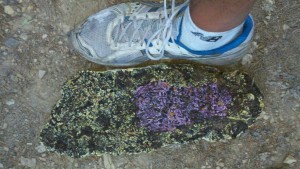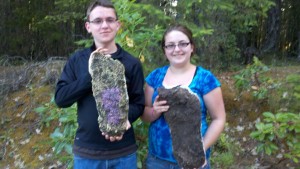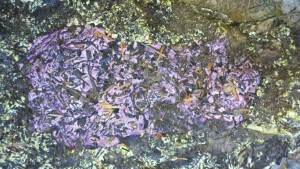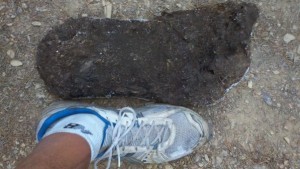Tracking Juvenile Bigfoot With Matthew Johnson
Posted by: Loren Coleman on August 25th, 2011

On the evening of August 24, 2011, I had dinner with clinical psychologist Matthew Johnson. Matt is known for his Bigfoot encounter over the first July weekend in 2001, at the Oregon Caves. He is in Portland, Maine, in conjunction with his positive parenting talks he delivers around the country.
Our dinner served as a good chance for us to meet and talk, mostly about Sasquatch, of course.

If you have never met the man, first off, the friendly and personable Matt is large. At 6 ft 9 inches, his 2001 sighting of what he sensed was a large Bigfoot is placed in an important context. The creature was much bigger than this tall human. Matt is a credible witness, from my past interactions with him, long distance, and this was only reinforced when I interviewed him over dinner and afterward.

We spent this good evening talking about the hairy hominoids. Matt shared that he has actively been finding evidence of Bigfoot in recent months. His experiences have involved incidents of locating tracks and hearing vocalizations, from Oregon to Washington.

The Siskiyou Mountains are a coastal mountain range in the northern Klamath Mountains in northwestern California and southwestern Oregon in the United States. They extend in an arc for approximately 100 miles (160 km) from east of Crescent City, California northeast along the north side of the Klamath River into Josephine and Jackson counties in Oregon. The mountain range forms a barrier between the watersheds of the Klamath River to the south and the Rogue River (in Oregon) to the north.
One of the more interesting discoveries was Johnson’s find of a good juvenile Bigfoot’s track within its mother’s track. The juveniles’ prints are naturally hidden from human trackers because the young Sasquatch are following in their parents’ footsteps.
When you think about it, this is an obvious conclusion. Reflecting on this, I certainly know my sons, when they were boys, put their footfalls in mine at the beach and in walks in the snow. It is a protective adaptive behavior of many animals, and makes total sense that this would be happening with Sasquatch.

Female track with juvenile track imposed on it next to Matthew A. Johnson’s size 16 shoe. July 9, 2011.

Johnson family members hold finds: Morgan found the female track with the juvenile track imposed on it about 15 feet away from the male track that Claire found on July 9, 2011.

Juvenile track found imposed upon what seemed to be a mother’s track, obviously following mom. This combined track was found July 9, 2011, about 15 feet away from the apparent male track.

Male track next to Matthew A. Johnson’s size 16 shoe. July 9, 2011.
Here are clips, reviewing Johnson’s 2001 sighting (see his BFRO-submitted report here), for those that need a refresher, below:
http://www.youtube.com/watch?v=KIx2Wft80_0
After the Skookum Cast in the first segment, in the second section, around 8:11, the Matthew Johnson sighting is overviewed:
And for some Oregon background…
http://www.youtube.com/watch?v=BW2SUKmjv8w
BTW, it always struck me as one of the wonderful coincidences of the 2001 event that the Oregon park ranger, known for his tracking skills, who was pulled into the investigation the day after Johnson’s sighting was John E. Roth, the author of the 1997 scholarly book, American Elves: An Encyclopedia of Little People from the Lore of 380 Ethnic Groups of the Western Hemisphere
About Loren Coleman
Loren Coleman is one of the world’s leading cryptozoologists, some say “the” leading living cryptozoologist. Certainly, he is acknowledged as the current living American researcher and writer who has most popularized cryptozoology in the late 20th and early 21st centuries.
Starting his fieldwork and investigations in 1960, after traveling and trekking extensively in pursuit of cryptozoological mysteries, Coleman began writing to share his experiences in 1969. An honorary member of Ivan T. Sanderson’s Society for the Investigation of the Unexplained in the 1970s, Coleman has been bestowed with similar honorary memberships of the North Idaho College Cryptozoology Club in 1983, and in subsequent years, that of the British Columbia Scientific Cryptozoology Club, CryptoSafari International, and other international organizations. He was also a Life Member and Benefactor of the International Society of Cryptozoology (now-defunct).
Loren Coleman’s daily blog, as a member of the Cryptomundo Team, served as an ongoing avenue of communication for the ever-growing body of cryptozoo news from 2005 through 2013. He returned as an infrequent contributor beginning Halloween week of 2015.
Coleman is the founder in 2003, and current director of the International Cryptozoology Museum in Portland, Maine.










Pretty interesting find. However, just like Josh Gates is up to his eyeballs in folklore (somewhat his words in the Ropen episode of Destination Truth), we are up to our eyeballs in tracks.
Nothin’ says Discoverin’ like a body and Fox’ News’ a’comin’! 🙂
This gentleman is getting pretty close to Sasquatch size himself!
Hey is there anything to the theory that Bigfoot is a Homo heidlbergensis or H. heidlbergensis descendant? Just wondering.
I always found this particular event very credible. It also shows the creatures curiosity and harmless naure as well.
One thing regarding the juvenile track with-in the adults is how could the stride length of a juvenile match to that of an eight foot adult ???
I find Dr. Johnson’s encounter extremely compelling and credible. He had much more to lose than gain by coming forward. After all, who want’s their therapist to be a guy who saw an 8′ bipedal ape in the woods of Oregon? Kudos to Dr. Johnson for his work.
All of these videos mention finding out more about Bigfoot so we can protect them. If they exist do they really need our protection? Seems to me that they are protecting themselves just fine. This just all seems very egotistical of us.
CryptoNY…Good question.
I imagine that maybe the juvenile trying to stay within the footprints of the larger adult would be something of a game where the juvenile hops from one print to another. My kids used to do that and for some reason absolutely loved it. Another thing is we may not recognize juvenile tracks as Bigfoot tracks because well, they aren’t big like we expect Bigfoot tracks to be. Also the juveniles would not be nearly as heavy as an adult so maybe the print is not as defined.
All this is, of course, just my opinion.
To RWRidley, who says we’re apes?
Don’t take offense, Bigfootsdad. I consider myself an ape.
@bigfootsdad: the scientific consensus is that H. sapiens is part of the great apes family. It would appear that Sasquatch would also be classified as such, once its existence is scientifically confirmed.
speaking of science, I wonder if Dr. Meldrum has had a chance to analyze the prints?
Elmer’s account does not strike me as credible. Aside from the behavior he described his retelling sounds like it is rehearsed. I’m not saying what he says happened didn’t happen, but he is not remembering an event. He is describing something that he has told and re-remembered many times. I’m certain memory biases have filled in some details that were not in the actual experience of the event.
If a Squatch were to fall down a hill, which seems unlikely because an animal that has detected something unusual in its space, will have be more aware of its surroundings. I doubt it would casually walk away. At the very least I would imagine it being protective in its stance and behavior. A fight-or-flight reaction would seem more natural to falling down a hill into potential danger.
…I’m just saying.
🙂
😛
Matthew Johnson’s account seems very credible to me. I’m a father and if I experienced what he did I would do the same thing … I hope. Also as he was recounting what he experienced he slightly broke down when the realization of what he saw, and the potential danger that his loved ones were in happened. It is an honest human reaction.
Elmer?
@Joxman, I missed that one too. Who’s Elmer?
I think he’s talking about Elmer Frombach, Jr., the guy shown on the bottom video.
And again could anyone tell me if there’s something to the theory that bigfoot is a Homo heidelbergensis?
Why did Dr. Johnson abandon the Southern Oregon Bigfoot society? They posted to their own website regularly and appeared to have some breakthrough activity – then the website and all of them disappeared. Now he’s back?
@ PikeBigFoot -“I imagine that maybe the juvenile trying to stay within the footprints of the larger adult would be something of a game where the juvenile hops from one print to another” I think (and no proof here….) that, considering Bigfoot’s secretive lifestyle, this make show an instinctive trait the survival. The young’uns step in the adult’s footprints ’cause they are programmed. We haven’t gotten solid proof of their existence because ofthe many ways they keep a low profile. Note the whole-body print of a bigfoot laying down to eat the food. WHY? …because they aren’t as noticeable that way. They instinctively stay behind trees away from sounds they hear.
@Cryptoz -We can’t address the relation of bigfoot to known humanoids. They MIGHT not be a relative of any. They might be a new hominid, but they might be a wombat. Until there is a body, or a scientifically studied classification (C’mon, Dr Ketchum…we’re counting on you!), all we can do is conjecture.
*MAY show an instinctive trait FOR survival* Dang! and I proof-read it, too!
Cryptoz: the only way we could determine any connection between a fossil hominid and Sasquatch is to have a comparitive specimen of Sasquatch, so no, there isn’t anything to it currently… Now go out and find that comparative specimen!
Sorry folks if you were confused by my comment. I was referring to Elmer “Skip” Frombach Jr. account in the Unsolved Mysteries: Bigfoot in Oregon YouTube video that was posted.
The fact that human children do the same thing, stepping onto their parent’s footprints in sand and mud, is very interesting. Is this a throwback behavior of some sorts or is in an ingrained instinct for young apes to ‘play’ this game for reasons of safety? Or maybe just a coincidence?
I would say in addition, juveniles are not reported because the tracks are too easily confused with human tracks.
I have a environmental scientist friend who reported finding a child’s naked feet tracks along a mud riverbank, deep in the woods by the small town of Yale on Vancouver island, in an area with no public access or roads, far from any settlement. He was perplexed by the find.
It’s very likely what he indeed found was a juvenile sasquatch’s tracks.
I found 14 inch tracks on Mt. Provost near Duncan BC, in more than one location. 14 inch is approaching human foot length, especially in a padded snow boot, and so you can easily see when the tracks drop into the 13 to 12 inch category they quickly fall into the ‘noise’ of human tracks. If I hadn’t found the clear toe impressions in the fresh snow tracks, I would have had to regard them all as inconclusive.
And I would also say that it’s just as common to find juvenile tracks beside adult tracks as it is to find them embedded within tracks. Jeff Meldrum indicated at the Harrison Hot Springs conference that the individual known as ‘Patty’ was matched to identical tracks that were found a month or so before the Patterson video, walking with two juveniles, in an area near Bluff creek.
Regarding the Matthew Johnson encounter; I find it more than interesting that Matthew being of the huge stature he is, had such an up close and conspicuous encounter with that particular sasquatch. For any one that hasn’t seen the entire multi segment video production available on the newspaper website (see Grant’s Pass Daily Courier), subsequent evidence in the park only lends additional creditability to an already totally believable encounter report.
Has anyone else made the connection between Matt’s incredible size and that of the adult (probably male) sasquatch?
I’m of the persuasion that several factors were at play and that may have lead to the encounter.
1) Territorialism: I believe that sasquatch males are highly territorial of other male sasquatches, much more so than any territorial behavior directed towards the average human male. I feel certain that many woods travelers are observed by sasquatch every day, but very few allow their presence to be known. Matthew’s size would certainly become very interesting for any dominant male sasquatch in the area. As we see, Matt’s physical stature is well outside the norm.
2) The need to breed; Like all males the sex drive is one of the strongest if not ‘the’ strongest natural instinct. The fact that Matthew was accompanied by a female would probably instigate heightened curiosity. Matthew may have been very close to an aggressive / confrontational challenge for his wife. The chuffing heard by every family member would lead me to believe that the sasquatch wasn’t particularly cautious about being observed. I mean absolutely no disrespect towards Mrs. Johnson, but I have to wonder if her obvious attractiveness may have caused even a more heightened interest.
3) This speculative scenario among others is bore out by the observation by all the Johnsons of the oft reported typical sasquatch odor. As we know, in male gorillas, the large apocrine glands produce a viscous fluid that when oxidized by contact with the air create a horrendously rank, (and probably individualistic) odor. The release of this fluid seems to be controlled by the individual and as studied by primatologists has definite social and sexual significance. In a side note it would be interesting to study the possible correlation between the approximate 45% of observations reporting a foul odor and the proximity of females in those reports.
If any of the above has any merit we have to wonder why the challenge never took place. Only the big guy (the hairy one) really has this answer. If we construct a crude timeline of the encounter we might conclude that;
1) The sasquatch was aware of Matt and his family before they were cognizant of his presence.
2) The sasquatch probably behaved exactly as he would have if he were observing a competitor in his territory, probably, in sasquatchese; vocalizing and giving his intruder an opportunity to vanish.
3) Having not persuaded the intruder to leave, his next reaction was to observe the prize and assess his options, then he became disinterested in Matt, having decided it was no real contest in any vie for dominance.
4) Turning his attention to observing Mrs. Johnson and her children, perhaps, out of some unspoken code of sasquatch ethics, the alpha male departed.
Yes I know this last speculation is a stretch, but in my opinion, worth a thought.
I have been of the opinion now for a long time sasquatches commonly observe humans in their territory. The vast majority are never aware of the creatures presence as the sasquatch chooses almost invariably to remain hidden and unseen. Its only when there is specific cause for close or prolonged investigation that we might become aware of the sasquatch. This is not to imply that these creatures aren’t diligent in maintaining the integrity of there territories—they are. I believe that they are able to discern trespass on an almost sub-conscious level. There senses are so finely evolved that we may not even be able to speculate as to their acuity.
We should consider this when ever we enter the deep wilderness. I know that in the case of brown bears, as huge and lumbering as they are, they know how to remain inconspicuous and hidden, sometimes within a few yards of a spot I had just passed. This has never much concerned me while in the woods, but afterwards when reviewing the days or weeks activities/hunts, I often have my own apocrine gland episode, with hair standing on end at just the thought of what transpired…or didn’t! How much finer though the abilities of an adult sasquatch to detect and evade than even the knavish brown bear..